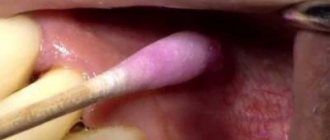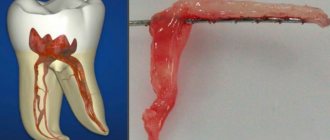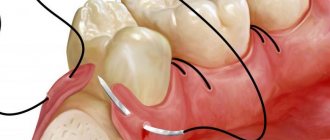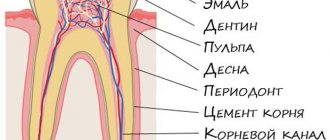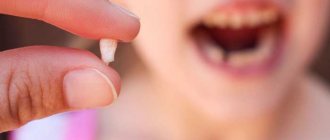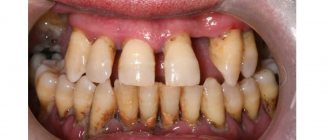Indications for removal of baby teeth
In the absence of pathologies and good dental health, the renewal of the child’s bite begins at approximately the age of 5-7 years. The permanent molars are already ready to replace the baby teeth, so the latter become mobile and often fall out on their own.
The ideal scenario makes everyone happy, but sometimes the removal (extraction) of baby teeth is an objective necessity. Indications are determined by the dentist:
- Loose baby teeth. The strong mobility of the changing tooth bothers the child. Unpleasant sensations occur when talking or eating. There is a danger of gum inflammation.
- Supernumerary tooth. An extra unit interferes with the formation of a correct bite, so after consultation with an orthodontist it is often recommended to be removed.
- Beginning of permanent molar tooth eruption. In this case, the baby tooth becomes a nuisance, which it is advisable to remove as soon as possible.
- Severe tooth decay due to deep caries, pulpitis or periodontitis. The dentist will make every effort to save the baby tooth, but in case of serious damage to the crown, there is only one solution - removal.
- Crack and mechanical damage. A crown split, root fracture and other consequences of severe trauma are a reason to remove the destroyed unit.
- Bite correction. To ensure the correct positioning of teeth in the jaw, it is often necessary to forcefully remove individual units. But this is done after consulting an orthodontist.
- Inflammatory processes in the area of the tooth root. Granuloma, fistula or cyst is a threat to the health of the root system of permanent elements. Usually, the doctors at AzaBuka Pediatric Dentistry manage to cure the inflammation. If not, removal is inevitable.
The reasons for the removal of temporary teeth can be very different, but modern pain relief techniques make the extraction procedure painless and comfortable for the child. It is best to schedule an adaptation visit as your first appointment. If the baby is already familiar with doctors, then you can immediately make an appointment with a dental surgeon.
Adaptation in dentistry is a series of introductory sessions for children, during which children are introduced to the work of dentists, equipment, and tools. Communication takes place in a fun, playful way with the display of informational cartoons, fairy tales, and interesting dental models. After adaptation techniques, children cease to be afraid of doctors and willingly agree to all types of treatment.
How do children's teeth work?
Children have an order of magnitude smaller teeth than adults. In addition, they are much smaller in size than permanent ones, are less durable, and are easily susceptible to the destructive influence of caries.
Pulp - loose fibrous tissue that fills the internal cavity of the tooth - occupies a very large space and is covered with a relatively thin protective layer. It is where blood vessels and nerve endings pass. This means that there are nerves in baby teeth and they can hurt no less than molars.
As for the characteristics of the root system, it is less developed in children than in adults. This is due to the need for root resorption during the period of change of bite .
Dentists never tire of repeating: baby teeth are complex systems in structure, and their condition affects the health of future molars. This is why most people who ignore the need to visit the dentist in childhood have serious dental problems at a young age.
Many parents do not pay enough attention to the health of their children's smiles. They explain their position by the fact that very soon the roots will resolve anyway, and the crown will collapse. But thinking like that is irrational and even dangerous. The inflammatory process can move to the root germ, then there is no need to talk about any healthy change.
Moreover, it is inhumane to deny children dental treatment. Indeed, with severe tissue destruction, they will begin to experience unbearable pain. If you treat caries at an early stage of its development, serious problems are guaranteed to be avoided.
Is it painful to remove a child's baby tooth? Anesthesia decides everything!
The question of tooth pain relief during extraction is the most frequently asked question by parents. The wishes of adults vary: some want extraction without medications, others insist on full anesthesia. AzaBuka provides several anesthesia methods for children, and when selecting, the doctor always focuses on the individual characteristics of young patients.
In rare cases, they do without pain relief. This is real if the baby tooth is very mobile, and its permanent replacement is already emerging through the gums. In this case, the doctor removes the tooth during an examination of the oral cavity, and the child does not even notice the manipulation. There is simply no point in worrying about whether it is painful to remove a baby tooth in children, but such techniques are rare.
Plaksina Margarita
“One young gentleman had his upper tooth so loose that it was turning in all directions. But it didn't fall out. The boy did not let his parents pull the tooth, but he allowed himself to be examined at the reception and quite willingly opened his mouth. Imagine his surprise when I put the pulled out tooth on his palm literally a minute later. He left happy - with a reward for courage and a milk tooth in his hand.”
Most often, dentists resort to local or thorough anesthesia - they use one of the types of modern anesthesia:
- Superficial. The doctor treats the gums with a special gel that gives a slight freeze. This is done for easy removal of highly mobile teeth or at the site of a future anesthetic injection.
- Local (infiltration). To administer the anesthetic, the doctor uses a syringe with a very thin needle, so the discomfort is minimal. The selection of the drug is carried out in the presence of parents to eliminate the minimal likelihood of an allergic reaction.
- Sedation, shallow sleep. The technique is becoming increasingly popular - both children and adults enjoy it equally. Using an inhalation mask, the child is offered to breathe a special gas - a mixture of nitrous oxide and oxygen. The relaxing effect puts the patient into a state of semi-sleep. The baby understands everything, can follow the doctor’s requests, but does not panic, is not nervous or worried.
Why do baby teeth hurt?
The fact that dental treatment is necessary at any age is irrefutable. But why do kids get toothache so often? There are several explanations for this, and they all have to do with the structural features of children's teeth. This means:
- Very thin and insufficiently mineralized enamel. It cannot withstand the aggressive influence of sugar, traumatic damage, or mechanical stress. It is easily destroyed by the accumulation of soft plaque, in which pathogenic microorganisms actively multiply. It is because of this that in children, caries in the form of a spot can turn into a huge “hollow” in a few weeks. Then the deep layers of the child, pulp, and nerve endings become involved in the destructive process.
- Quite thin dentin. This promotes the rapid transition of bacteria from the external tissues of the tooth to the internal ones.
- Large pulp volume. It can be considered as suitable conditions for the spread of pathogens.
Most often, doctors diagnose caries in children. If you treat it immediately after the appearance of a white or dark spot, the prognosis will be favorable. Most likely, the unit will remain until it is pushed out by a more durable permanent replacement. If you let the carious process take its course, within six months or a year the destruction will become so extensive that it will have to be removed.
General anesthesia.
Removal or treatment of teeth in a dream is prescribed for certain indications. The appointment is carried out under the supervision of an anesthesiologist with the mandatory use of monitoring equipment.
Dolotova Marina
“Is it painful to remove a baby tooth for a child under sedation - if it doesn’t wobble? Absolutely not. Usually during the appointment, the children watch cartoons while I carefully remove the tooth. And before that, we play superheroes with them and be sure to try on a real mask - a prototype of the Iron Man helmet!”
Content:
- How do children's teeth work?
- Why do baby teeth hurt?
- Why you shouldn’t be afraid to treat your child’s teeth
Very often, a visit to the dentist becomes a real test for both the child and his parents.
At the same time, mom and dad may worry even more than their baby. They are concerned about the question of whether it is painful to treat baby teeth, since they do not want standard filling of a carious cavity to become stressful for the baby and form a negative attitude towards dental treatment. We suggest finding out whether children experience toothache and whether there are nerves in their baby teeth. To do this, we will first talk about the structural features of temporary incisors, canines and molars.
Holes in teeth and increased sensitivity
Increased sensitivity of teeth (hyperesthesia) does not mean that a carious cavity has appeared; it is an alarming signal that help is required. Symptoms indicate that there is a hole in the tooth are varied, and the diagnosis is made by a dentist. Please do not self-medicate at home. Don't think that caries will go away on its own.
Treatment by a dentist will relieve the unpleasant symptoms of pain and further destruction. Med-Stom.Com - serious dentistry for ridiculous money... Along with “folk” myths about holes in teeth, there are also true statements.
Frequent consumption of sugar and sweet foods can destroy dentin. The disease is the result of bacteria that feed on carbohydrates contained in sugar, flour products, potatoes and other foods. By breaking down carbohydrates, bacteria produce acid that destroys tooth enamel, causing holes to appear in adults and children.
In addition to sugar-containing foods and drinks, products enriched with acid pose a danger to the patient’s tooth enamel tissue. Citrus fruits will not directly cause the formation of holes in the teeth, but they weaken the enamel, causing caries to develop. Caries forms on any part of the tooth, often holes appear between the teeth. There is an explanation for this. Food debris often accumulates between the teeth and cannot be removed even by using a flexible toothbrush.
When is a child's dental nerve removed?
The main indication for removing a nerve in a child’s tooth is pulpitis.
The disease is characterized by inflammation of the pulp, in the tissues of which there are vessels and the nerve itself. Pulpitis is accompanied by severe pain, deterioration of general condition and weakened immunity. There are risks of inflammation spreading and complications developing. Nerve inflammation is a complication of deep caries. Microbes that penetrate the dentin gradually infect the pulp, resulting in pulpitis. If treatment is not carried out in a timely manner, the pathological process begins to progress, gradually spreading to the soft tissues, and then to the jaw bone.
Removal of the nerve of baby teeth is not carried out only if the child has already begun the process of changing teeth, and a permanent tooth is growing in the coming months. An x-ray is taken to determine the prognosis. For such indications, tooth extraction is performed, since there is no risk of bite displacement.
Is it possible to completely prevent the development of caries in childhood?
Perhaps, if parents conscientiously follow all the doctor’s recommendations regarding nutrition and the prevention of carious lesions, they systematically come for preventive examinations, which are prescribed by the attending physician.
It is necessary to take care of baby teeth and carry out treatment in a timely manner. You need to take care of your child’s teeth from the appearance of the first tooth. Parents should approach oral care responsibly, teaching their child to take care of hygiene. It is not difficult to interest a child now - parents will be helped by unusually designed toothbrushes, pleasant-tasting toothpastes, and, if desired, even such a routine activity as brushing teeth can be turned into an interesting game.
Pediatric dentistry will help you - during your appointment at our clinic, hygiene lessons are held - specialists tell and show how to properly brush your teeth. Let your children be healthy, happy and smiling!
About holes in teeth
Adults mistakenly cause holes in children's teeth more often. It is not true. Carious cavities occur regardless of a person’s age. As medical statistics show, it is present in 90% of preschool children, while 95% of adults have at least one carious cavity.
Adults often take medications, and the risk of development increases significantly. Medicines cause dry mouth, and lack of moisture is the cause of the disease.
Saliva partially quickly cleanses the enamel surface of food debris, plaque, and dangerous acids produced by bacteria. Through saliva, teeth receive calcium, which is necessary for strong enamel.
What symptoms should you contact your dentist for?
Ideally, you should visit the dental clinic with your child every six months, and if signs of caries appear, treatment should begin immediately. But more often, parents turn to specialists when their child begins to suffer from severe toothache.
You should make an appointment with a dentist if your child exhibits the following symptoms:
- feeling of bursting and dull toothache;
- reduction of pain after eating hot food or during sleep;
- tooth sensitivity when eating;
- purulent odor from the mouth even after brushing your teeth;
- extensive carious cavity;
- other damage to the dental crown.
Pulpitis is characterized by rapid progression of the inflammatory process. If the nerve is removed at the initial stage, there will be no complications. In advanced cases, the pathological process can develop into a cystic or granulomatous form, or the infection begins to spread to the jaw bones or sinus tissue.
Treatment of pulpitis
If the infection is located near or has already reached the pulp chamber of the tooth, completely different treatment methods are used.
- Direct pulp capping. With this method of treatment, the viability of the entire pulp is preserved.
- Pulpotomy (vital amputation). The infected coronal part of the pulp is removed, its root part is preserved for further development of the tooth.
- Pulpectomy (pulpoextraction). The pulp is completely removed, after which the root canals are filled.
If a small patient is brought to the clinic in a timely manner, pulpitis can be cured in one visit.
Dentist recommendations
Your baby needs to brush his teeth 2 times a day from the moment the first tooth erupts. This must be a mandatory and strictly observed rule. In this case, teeth cleaning should be of high quality; the recommended duration of the procedure is 3 minutes.
- How to choose a toothbrush for a child?
The toothbrush should be of medium hardness; pay attention to the markings according to the child’s age.
- Which toothpaste should you choose?
From 3 years of age, it is better to use toothpaste with fluoride, selected according to the child’s age.
- Oral hygiene
Teach your child to use dental floss to clean spaces between teeth that are difficult to clean with a brush.
- Reduce your intake of sweets
If possible, reduce your consumption of sweets - sweets, lollipops, cookies, sweet soda! If a child has eaten a product with a high content of carbohydrates - and they are dangerous for baby teeth - be sure to brush the teeth and do not leave food for bacteria on the teeth. If your child has a sweet tooth, give preference to marshmallows and marmalade, but, of course, in limited quantities.
- Scheduled visit to the pediatric dentist
Visit your dentist twice a year for professional hygiene, starting at age 3. Medical examinations twice a year should also be on your list of mandatory events.
- Child's diet
Include more hard foods in your child's diet - fresh apples, carrots, and boiled meat are useful. Food should not only be soft or pureed.
More detailed and individual recommendations are given after examination and consultation in our clinic.
Consequences of nerve removal
In the first 1–2 days after treatment, the tooth may hurt, but the intensity of the pain gradually decreases. To alleviate the condition, you can take analgesics recommended by a specialist. There are no other consequences of nerve removal.
Since pulpitis is most often caused by caries, during the treatment process the dentist removes the affected crown tissue. Restoring the integrity of the tooth is performed after removing the temporary filling. For correction, a filling material that does not contain toxic substances is used. In some cases, when the area of the carious cavity is too large and there is a risk of the filling falling out, it is recommended to install prostheses (stump or artificial crown.
Many parents mistakenly believe that depulpation implies the absence of a nerve in a permanent tooth. However, this is not at all true. Temporary and permanent teeth have separate systems and tissues that are not interconnected.
Martinka Children's and Adolescent Dentistry treats pulpitis by removing the nerve. Timely and correctly performed removal of the nerve of a baby tooth has no consequences. The integrity of the tooth is restored, and its functionality is preserved.

